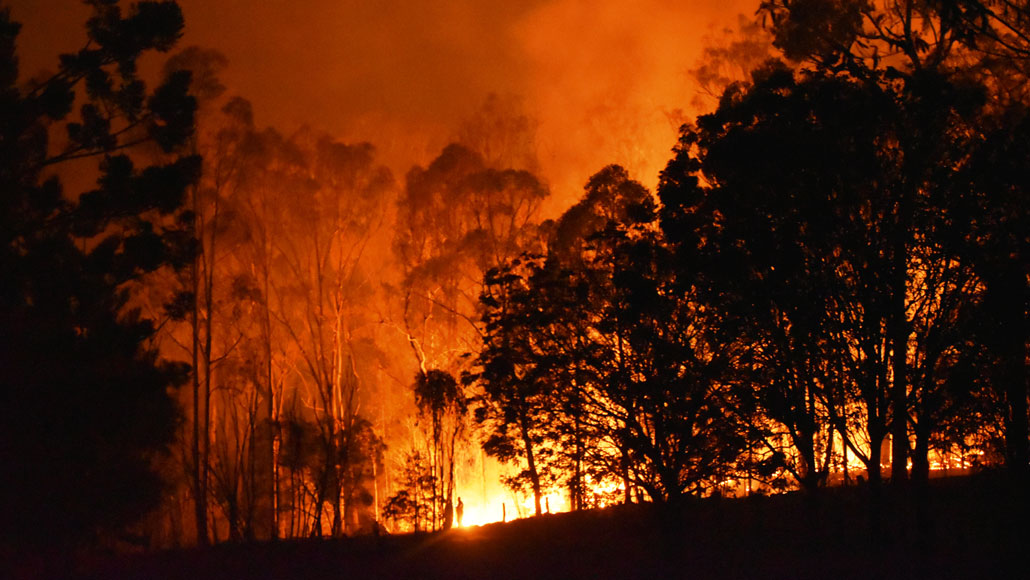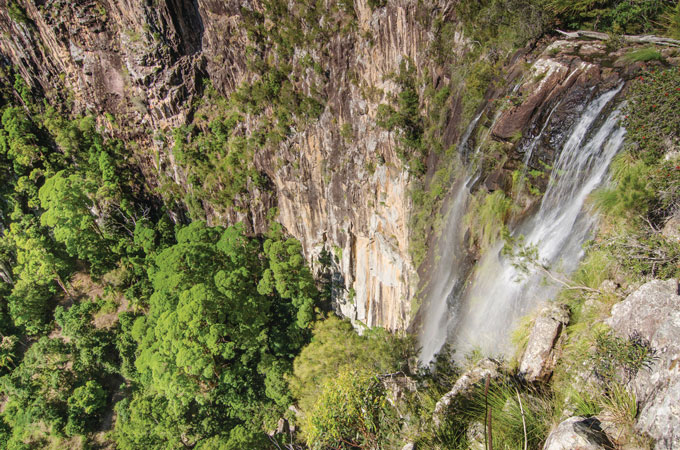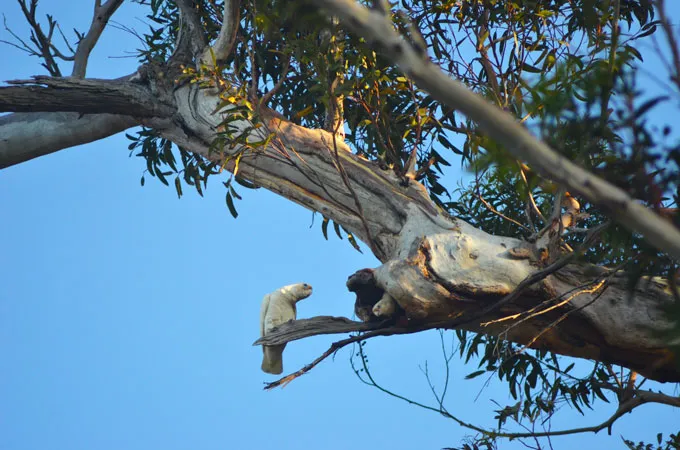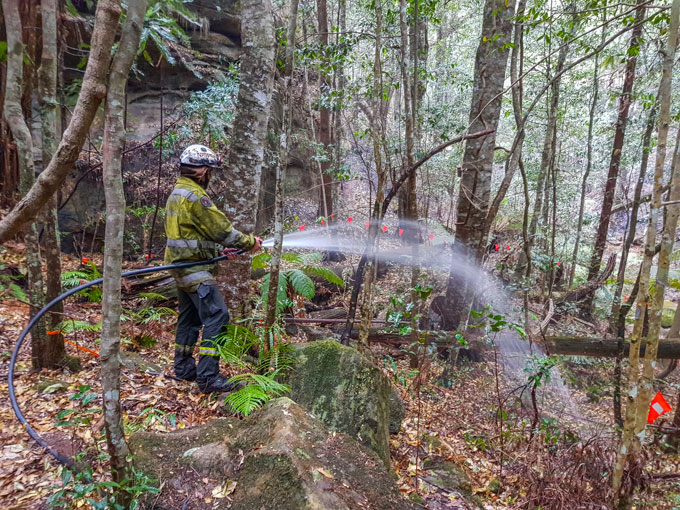Will Australia’s forests bounce back after devastating fires?
Scientists are worried about ecosystems not used to such frequent, blistering blazes

Massive wildfires across Australia (one shown in Queensland in December 2019) this fire season have scientists wondering if some of the country’s globally important forests can recover.
philips/iStock/Getty Images Plus
- More than 2 years ago
Some of the world’s most ancient rainforests lie in the north of the Australian state of New South Wales. Continually wet since the time of the dinosaurs, these forests once covered the supercontinent Gondwana. Today, vestiges harbor many endemic and evolutionarily unique plants and animals.
“Normally vibrant, green and lustrous,” these forests “feed your soul,” says Mark Graham, an ecologist with the Nature Conservation Council of New South Wales, who is based in the region. “You step into them and breathe deeply, and you are at peace.”
Typically moist, these environments don’t burn. But unprecedented fires have now ravaged more than 11 million hectares in eastern Australia, penetrating these strongholds that rarely, if ever, faced fires before.
Last year was Australia’s hottest and driest year in 120 years. Made vulnerable by a record drought and heat wave, more than 50 percent of the vast area that makes up the Gondwana Rainforests World Heritage Area has gone up in flames, Graham says. “There’s now concern about the long-term viability of these globally significant forests.”
Drier types of Australian forest, which have some fire tolerance, could be taking a beating too in the wake of blazes that, as researchers report January 8 in Global Change Biology, are becoming more intense and frequent with climate change. “Most of our eucalyptus forests and woodlands have had a long history of fire,” says John Woinarski, a conservation biologist at Charles Darwin University in Darwin. But, like their wetter counterparts, “they’re burning, in many cases, not long after the last major fire in these environments.”
Overall, more than 50 percent of the entire ranges of about 115 threatened plant and animal species have gone up in smoke, many in eucalypt forests in the continent’s southeast, Australian officials reported January 20. The question now is: Can these areas, especially the forests that are the foundation of so many Australian ecosystems, recover, or are they forever changed?
Waiting for answers
“We are in uncharted territory,” says Richard Hobbs, an ecologist at the University of Western Australia in Perth. “We haven’t had fires so early in the season and covering such large areas before. We’ve had ecosystems that haven’t burned in living memory going up, so how they are going to respond is anybody’s guess.”
Environments likely to be hardest hit are those with an infrequent history of fire and little tolerance to it. Take the tall, wet forests in the southeastern state of Victoria. They have now experienced their fourth fire in 20 years, Woinarski says, and that’s slowly removing their dominant mountain and alpine ash trees. One 2013 study in Global Change Biology warned that increasing fire frequency could lead to the loss of these types of forest: There isn’t enough time for the trees to reach maturity and produce viable seeds for the next generation before another fire comes through.
Botanist Robert Kooyman has seen firsthand what the fires have done to another forest, this one in Nightcap National Park, part of the Gondwana Rainforests. In the 1980s, Kooyman, who is based at Macquarie University in Sydney, found and described the Nightcap oak (Eidothea hardeniana), a critically endangered endemic tree. He was one of the first scientists to return to Nightcap in January after the 2019–20 fires swept through.
Now, the rainforest floor is blackened, he told Science News from the field. Scorch marks higher in the trees reveal the fires’ appetite. The blazes burned through the thin bark of many rainforest trees, which are “still green and clinging to life, but doomed,” he says.
Seeing this kind of damage in environments where he’s worked for 40 years was “emotionally tough,” Kooyman says. “Sadness, like the smell of burned ground and the last residues of smoke, hung heavy on the air.”

His initial surveys suggest that 10 percent of the rare Nightcap oaks, which numbered just 250 before the fires, are dead, but more may succumb with time.
That’s just the tale of one species. In Nightcap National Park alone — one of 30 parks and reserves that make up the Gondwana Rainforests — 16 threatened plants and 27 threatened animals have been affected by fire, including the peach myrtle (Uromyrtus australis) and Albert’s lyrebird (Menura alberti), a pheasant-sized, ground dweller that mimics other birds.
Mature trees of some species here can be 500 to 1,000 years old, which means full recovery won’t happen until well after our life spans, Kooyman says. Regeneration will come from resprouting on some trees and the emergence of new seedlings. But the loss of large trees, which form the canopy and are major producers of fruit for animals to eat, will damage how this entire ecosystem and food web functions, he says.
Limits of tolerance
Australia’s more arid habitats, its savannas, spinifex grasslands and dry eucalypt forests, evolved in the presence of fire. Within weeks or even days of fire passing through, burned species of eucalypt trees in these environments are famously able to throw out new buds and shoots from their trunks and the base of the trees.
The drought has not broken. But as some rains have started to return, regrowth is already being seen on gum trees like eucalyptus in more fire-tolerant habitats along Australia’s east coast. These places will burst back into greenery as heavy rains return in coming months, experts expect, but bigger problems may be brewing.
“Yes, some species are adapted to fire, but that doesn’t mean they are resilient to more severe, large and frequently occurring fire, which is what we are experiencing in some parts of Australia, because of the drought and climate change,” says Euan Ritchie, an ecologist at Deakin University in Melbourne. “If we see more and more of these really hot, large fires, even species that are somewhat fire-tolerant might become increasingly threatened.”
These fire-savvy species might only tolerate relatively infrequent or low-intensity fires, agrees Camille Stevens-Rumann, an ecologist at Colorado State University in Fort Collins. “When we see an increase in frequency, sometimes species are able to recover from the first fire. But if suddenly you have another one much sooner than it would have been historically, [a species] doesn’t have time to reach maturity and may not be able to reproduce,” she says.
In a report published in December by the U.S. Joint Fire Science Program, she and her colleagues found that trees in the Rocky Mountains — such as ponderosa pines, whose thick, jigsaw puzzle bark can often withstand fire — are similarly struggling to regenerate under hotter and drier conditions and increasingly frequent fires.
In dry eucalypt forests, severe fires can promote denser, shrubby style gum trees that are more flammable, exacerbating the problem, a 2018 study in Ecosphere found. And as more and more old-growth eucalypt trees fall to fire, the consequences will reverberate through the ecosystem. The trees’ large hollows, which animals from possums to cockatoos rely on to survive, take 50 to 100 years to form. While some hollows will remain in such forests, there will be increased competition for them. “It’ll be a fight for a diminishing resource,” Woinarski says.

Seed survival
Some plant species don’t just tolerate fire. They depend on it. Their seeds lie dormant in the soil waiting for the flames: They require the heat and smoke of bushfires to germinate and sprout.
The seedlings replace adult plants. “But if fires have been really frequent, that fire-stimulated seed bank might be depleted, so there might not be any seeds left to recover the ecosystem,” says Lucy Commander, who studies seed ecology at the University of Western Australia in Perth. A 2014 study in the Journal of Ecology showed that some plants in southwestern Australia that resprout from seed following fires were more likely to go locally extinct when faced with a combination of drought and shortened intervals between fires.
The problem of too-frequent fires depleting soil seed banks is not unique to Australia. A study published in 2004 looked at the impact of fires passing through the chaparral ecosystems of California’s Santa Monica Mountains more than every six years. Some species that usually resprouted following fires began to diminish, leading to a thinning of the shrubby ecosystem and the invasion of nonnative grasses.
Islands of greenery
The severity of Australia’s ongoing fires may cause other problems, too.
Normally when fires sweep through, they leave some patches unburnt by fluke or because of the topography of the landscape. “Those unburnt patches are really important for recolonizing of plant and animal species, back to the burnt landscape, as it is regrowing,” Woinarski says.
Those unburnt refuges are where animals can shelter from flames and eventually start repopulating surrounding burnt regions, preventing local extinctions, Ritchie and his colleagues reported in 2013 in the Journal of Applied Ecology. Surviving patches are also an important source of plants and seeds for revegetation.
But the intensity of fires this summer may mean “there will be far fewer refuge areas within burnt areas than is typical, or they may be too small to support viable populations of species,” Woinarski says.
Protecting — or even creating — refuges like these from fires will be increasingly important as the climate continues to change, according to a study in Global Change Biology in January 2019. That’s just what emergency workers did in December. As flames advanced on a hidden canyon in the Greater Blue Mountains, Australian firefighters raced to protect its rare occupant: the critically endangered dinosaur-era tree, the Wollemi pine. They doused the trees with water and fire retardant and then hoped. When the smoke cleared, some trees were charred, but the forest was still standing, government officials reported January 15.

Road to recovery
“There is a huge commitment across Australian society to try to recover from this tragedy,” Woinarski says. “We can’t give up yet on any of the species, environments, or vegetation types that have been so charred and degraded.”
One of the best things to do to help forests bounce back is to leave them to regenerate naturally and not disturb them further, Commander says. Clearing burnt vegetation and disturbing soils full of seeds ready to resprout can slow recovery.
In places where there are small patches of habitat left unburnt, “making sure that those continue to be protected, and can form nuclei for onward regeneration, is going to be an important thing,” Hobbs says.
But if the past is prologue, change is inevitable. As the continent drifted north, starting about 45 million years ago, the climate changed. “We know from the fossil record that these wet forests were lost in other parts of Australia, and aridity and fire is the likely explanation,” says David Bowman, a pyrogeographer at the University of Tasmania in Hobart.
Over time, some fire-tolerant dry forests could eventually turn into grasslands, and wet forests and rainforests could slowly shift into dry forests, or less dense savanna-woodland type habitats, experts say. In the wake of the 2019–20 fire season, some of those changes may be already under way. “The margins and parts of the [rainforest] core have been compromised, which means future fire events can penetrate deeper into what were previously permanently wet refuges,” Graham says.
Only time will tell what recovery looks like — and how far Australian forests can be pushed by fire before they pass tipping points that see them devolve into other types of ecosystem entirely. “We don’t really know the answer to that because these rainforests haven’t experienced fires recently. We haven’t really studied it,” Hobbs says.
Adds Bowman: “It’s a pyrogeographic experiment at a continental scale.”






